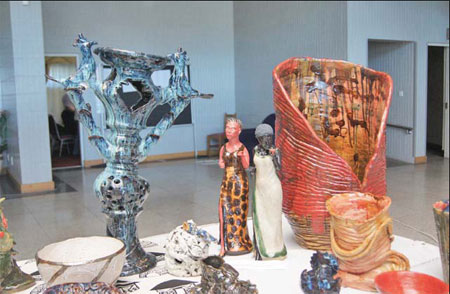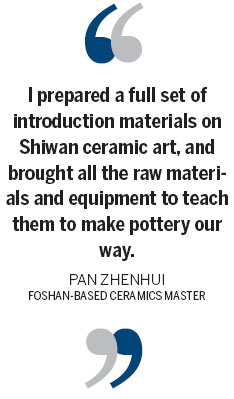
|
Above: Pan Zhenhui has managed to pass his Shiwan sculpture skills to Lesotho students despite language barriers. Below: Ceramics pieces created by Pan's 30 students in Lesotho. Provided to China Daily |


When Pan Zhenhui went to lesotho last year to teach the art of Chinese Shiwan Sculpture, he had a captive audience - some of whom were captives in more ways than one
Back in his hometown of Foshan, in southern China, ceramics master Pan Zhenhui often recalls his inspirational teaching trip to the Kingdom of Lesotho last year. Pan makes Shiwan ceramic sculptures, an art-form depicting people, animals, architecture and objects, which originated in Foshan. In January last year he was invited to Lesotho College of Education by the culture ministries of both China and Lesotho to teach ceramic sculpture techniques for two months.
"I prepared a full set of introduction materials on Shiwan ceramic art, and brought all the raw materials and equipment to teach them to make pottery our way," says Pan, 50, who has been making ceramic sculptures for more than 20 years.
His class was made up of about 30 students, including costume designers, professors, and six prisoners, who attended class under police custody.
The course included both theory and practical work. Following a theory class each student would make a ceramic piece under Pan's instruction and he would tell them how to improve.
According to Pan, his African students were inquisitive about everything.
"They saw my work and kept asking me how I make the Guan Yu figure, how I make the dragon head," he says. "They were also curious about the equipment, such as the withdrawal machine, the furnace and the different hand tools I use. They were very frank; some asked me, 'I like it, can you give it to me?' At first I was reluctant to refuse, but then I realized they would really take them away, including the hand tools. Later I said 'no' and made a gesture, telling them otherwise we don't have enough tools for the class."
Lesotho has its own pottery techniques, says Pan, but they are less sophisticated than those of Shiwan. The clay used is also hand-made and rougher than Chinese clay, which is mixed and ground by machine.
Shiwan is an extremely fine form of ceramic sculpture that requires a delicate touch and several complicated techniques, which Pan calls "mug, glaze and fire". Each of the three processes requires talent and years of practice.
He points to a ceramic figure of a girl in his studio. "Every small fold of her dress is not random. An apprentice must learn for at least three years until he knows exactly how to refine the folds," he says.
The firing is still more difficult, he says. Following shaping and glazing, the ceramic sculpture is placed into a furnace and baked at more than 1,200 degrees.
"The fire cannot be controlled and unpredictable; even the slightest disorder, like the humidity of the mug, can turn the sculpture into waste, and all your effort before will be in vain. That's why ceramics are fragile and very expensive."
Pan found his African students passionate about their work, even though communication was through an interpreter and gestures.
"They are full of imagination. The works they create are very colorful and correspond with their culture, although many times I did not understand what they had made," says Pan, showing a photograph of an orange ring made by one African student, engraved with creatures.
"I don't understand at all what it is but it has its own flavor."
Motsamai Moloko was Pan's favorite student. The 36-year-old costume designer had previously studied ceramic art at college and was keen to learn.
"At first we had language barriers, but we solved them quickly," Moloko says. "Pan made lots of animals and utensils to make it easy for us to follow. The most important thing I learned from him is that it's very important to be extremely patient while working with ceramic art.
Moloko made 45 pieces of work during the course, his favorite being a gift box with a traditional African hat on the top.
"I really like Chinese people and Chinese ceramic art. If I have the chance I will go to China immediately."
Moloko has applied for a scholarship to study ceramic sculpture in Britain and has ambitions to some day open a ceramics shop in Lesotho, where he will also teach the craft.
Pan was inspired by Lesotho's sweeping landscapes and interesting people and made two figures based on his time there, both of African girls wearing traditional dress. One wears a dress patterned with triangles, which symbolize the mountains of Lesotho, and both carry cotton tree flower, a popular flower from Foshan, in their left hand and are giving a thumbs-up sign, a common greeting in Lesotho, with their right.
Pan says the two pieces represent his wish that friendship between Lesotho and China will last forever and that his beloved Shiwan ceramic sculpture art will spread across Lesotho like a blooming cotton tree flower.
Wen Yangyang contributed to this story.
huangyuli@chinadaily.com.cn
